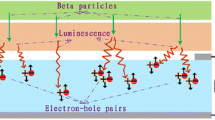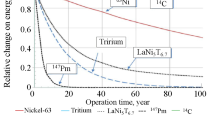Abstract
In a beta radioluminescence nuclear battery, the beta energy is converted to light with the phosphor material, and then to electricity via photovoltaic cells. A method to optimize the thickness of phosphor layer is established in this study; the match between the luminescence spectrum and the photovoltaic cell is analyzed. The optimal parameters and output performance of the nuclear battery based on a sandwich-structure 147Pm/ZnS:Cu/photovoltaic cell are determined with the MCNP, transport theory of light, and detailed balance limit of efficiency. The battery prototypes are fabricated and tested, and the experimental optimal thickness matches that of the theoretical result well.







Similar content being viewed by others
References
Liu YP, Tang XB, Xu ZH, Hong L, Wang P, Chen D (2014) Optimization and temperature effects on sandwich betavoltaic microbattery. Sci China Technol Sci 57(1):14–18. doi:10.1007/s11431-013-5413-0
Tang XB, Liu YP, Ding D, Chen D (2012) Optimization design of GaN betavoltaic microbattery. Sci China Technol Sci 55(3):659–664. doi:10.1007/s11431-011-4739-8
Cress CD, Redino CS, Landi BJ, Raffaelle RP (2008) Alpha-particle-induced luminescence of rare-earth-doped Y2O3 nanophosphors. J Solid State Chem 181(8):2041–2045. doi:10.1016/j.jssc.2008.04.024
Walko RJ, Ashley CS, Brinker CJ, Reed ST (1990) Electronic and photonic power applications. The radioluminescent lighting technology transfer conference
Sims PE, Dinetta LC, Barnett AM (1994) High efficiency GaP power conversion for Betavoltaic applications. In: 13th Space photovoltaic research and technology conference, vol 1, pp 373-382
Sychov M, Kavetsky A, Yakubova G, Walter G, Yousaf S, Lin Q, Chan D, Socarras H (2008) Alpha indirect conversion radioisotope power source. Appl Radiat Isot 66(2):173–177. doi:10.1016/j.apradiso.2007.09.004
Prelas MA, Charlson EJ, Charlson EM, Meese J, Popovici G, Stacy T (1993) Diamond photovoltaic energy conversion. Second international conference on the application of diamond films and related materials
Prelas MA, Popovici G, Khasawinah S, Sung J (1995) In: Prelas MA, Gielisse P, Popovici G, Spitsyn BV, Stacy T (ed) Wide band-gap photovoltaics, Kluwer Academic Publishers, Dordrecht
Schott RJ (2013) Photon intermediate direct energy conversion using a 90Sr beta source. Nucl Technol 181(2):349–353
Weaver CL (2012) PIDECα: photon intermediate direct energy conversion using the alpha emitter polonium-210. University of Missouri–Columbia
Prelas MA, Boody FP, Miley GH, Kunze JF (1988) Nuclear driven flashlamps. Laser Part Beams 6(1):25–62. doi:10.1017/S0263034600003803
Bower KE, Barbanel YA, Shreter YG, Bohnert GW (2002) Polymers, phosphors, and voltaics for radioisotope microbatteries. CRC Press, Boca Raton, London, New York, Washington D.C
Smith WJ (1966) Modern optical engineering. McGraw-Hill, New York
Aronson JR, Emslie AG (1973) Spectral reflectance and emittance of particulate materials. 2: application and results. Appl Opt 12(11):2573–2584. doi:10.1364/AO.12.002573
Nelson J (2003) The physics of solar cells. Imperial College, London
Guo H, Lal A (2003) Nanopower betavoltaic microbatteries. In: Proceedings of 12th International conference on transducers, solid-state sensors, actuators and microsystems. doi:10.1109/SENSOR.2003.1215247
Katz L, Penfold AS (1952) Range-energy relations for electrons and the determination of beta-ray end-point energies by absorption. Rev Mod Phys 24(1):28. doi:10.1103/RevModPhys.24.28
Qin HF, Guo TL (2008) Preparation of tetrapod-shaped ZnO nanomaterial field emission cathodes by deposition method. Acta Phys Sin 57(2):1224–1228. doi:10.7498/aps.57.1224
Raybould D, Morris DG, Cooper GA (1979) A new powder metallurgy method. J Mater Sci 14(10):2523–2526. doi:10.1007/BF00737047
Acknowledgments
Supported by the National Natural Science Foundation of China (Grant No. 11205088), the Aeronautical Science Foundation of China (Grant No. 2012ZB52021), the Fundamental Research Funds for the Central Universities, and the Foundation of Graduate Innovation Center in NUAA (Grant No. kfjj130125).
Author information
Authors and Affiliations
Corresponding author
Rights and permissions
About this article
Cite this article
Hong, L., Tang, XB., Xu, ZH. et al. Parameter optimization and experiment verification for a beta radioluminescence nuclear battery. J Radioanal Nucl Chem 302, 701–707 (2014). https://doi.org/10.1007/s10967-014-3271-2
Received:
Published:
Issue Date:
DOI: https://doi.org/10.1007/s10967-014-3271-2




